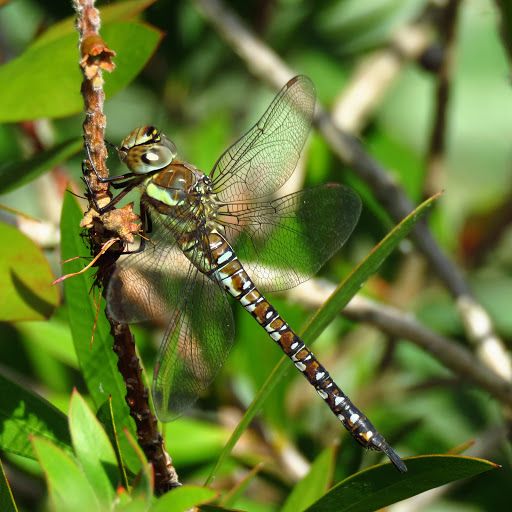
We've had some excellent dragonfly weather this August, with plenty of warm, sunny days. Although the last week had plenty of wind and rain, it was often warm enough even when overcast to entice some dragonflies out, until the very end of the month, dominated by cold northerly winds.
Odonata highlights
We've got a whooping 200 records from 12 species in the month of August. These are from at 35 1 km squares for August from 13 recorders, thank you all who have contributed records!
The season is over for many species (Hairy Dragonfly, Large Red Damselfly, Broad-bodied Chaser, Banded Demoiselle), and is coming to an end for others: Azure Damselfly, Four-spotted Chaser or Black-tailed Skimmer.
Migrant Hawkers (top shot) have been the top species, with a third of all, followed by Common Darter,and Blue-tailed Damselfly. Although there has been no new species added for the year in August, there is a chance we may still record Willow Emerald as the first records las year were in September.
Brown Hawkers
Brown Hawkers bumper year has continued, they are the 5th species in number of records for the month. In July many observations involved patrolling males on territory, but in August, ovipositing has been observed, twice at Foredyke Green (on the muddy shore, on floating wood and on floating polystyrene) and also likely ovipositing behaviour at East Park.
Female Brown Hawker rests between ovipositing bouts.
Oviposition on polystyrene.
Migrant Hawker
Most records involving hawkers away from water, hunting at 4-5 m high, sometimes in twos and threes are highly likely to be Migrant Hawkers in our area. Two or three individuals have been present regularly in my garden, and I was lucky enough to spot one of them basking quite low on a potted olive tree. It allowed for very close approximation.
A male Migrant Hawker Photo taken by my son with his mobile phone. 22nd August.
And a female, from the 31st of August.
There were several exciting Migrant Hawker highlights. One of them was to find a total of 6 exuviae at East Park. Exuviae is the formal name for a moulted larval skin, which can be found on marginal or emergent plants, after the adult has emerged. The presence of exuviae in a site provides evidence that a species has successfully bred in a site. As far as I know this is the first confirmation of successful breeding in the city of Hull after last years observed ovipositing in several sites.
Migrant hawker exuviae in situ.
Another interesting observation involved an individual flying underneath an ivy overhang and settling on it, moments before a rain shower. I found another individual near it. I wonder what makes the hawkers seek refuge, maybe the sudden darkening of the sky?
I was at Pearson Park Wildlife garden during muggy, but cloudy weather. During a sunny spell followed by a strong breeze, at least 20 migrant hawkers took to the wing and started hunting over the garden. This is the largest number of individuals I have seen of this species.
Finally, I have been able to observe Migrant Hawkers active during cloudy weather and temperatures as low as 13-14 oC. They might be able to achieve temperatures high enough for flight by basking during brief sunny spells. When windy, they forage around trees at the lee side of the wind in sheltered, sun-facing spots.
Blue-tailed damselfly mating behaviourThe following photo show a mating pair of Blue-tailed damselflies. In this species,
copulation is very long, up to 8 hours and in dense populations a form similar in colour to males increases in frequency, as these females avoid the costs of prolonged copulations.

Females oviposit alone. I was at Foredyke Green site about to take a photo of an ovipositing female, when a male came out of nowhere, knocked the female over, and immobilised her by holding her with jaws, legs and mating appendages. The following is a series of photos documenting how the male gains hold of the female, in the last photo he has already adopted the tandem position. I wonder had I only seen the last part of the behaviour, with the female already on the water, if I would have concluded that this was an example of a 'damsel in distress' being rescued by the male. I'm glad I got the whole sequence!
Small Red-eyed Damselfly
The Pickering Park and East Park populations are thriving: hundreds of individuals were present at East Park model boating lake and some as well in the main lake. A record in a new location was at St Andrews Quay Pond. The records show a establishment of the species in both large parks at Hull. Copulation and ovipositing was observed at East Park and Pickering park.
Small Red-eyed Damselfly at Pickering Park.

Small Red-eyed at East Park.
Small Red-eyed at East Park.
Copulating Small Red-eyed damselflies at East Park.
Best sites this year so far:
- East Park: 13 sp.
- Noddle Hill LNR: 12 sp.
- Foredyke Green Pond 11 sp.
- Oak Road Lake 9 sp.
- Pickering Park 8 sp.
- St Andrews Quay Pond 8 sp.
- Beverley & Barmston Drain 7 sp
- Paull Holme Strays 7 sp.
- Humber Bridge Country Park 7 sp.
- Pearson Park Wildlife Garden (closed due to COVID, but surveyed with permission) 6 sp.
- Willerby Carr Dyke, 6 sp.
- Beverley & Barmston drain, 6 sp.
Other species Gallery
Teneral Common Darter.
Common Darter in obelisk position
Emerald Damselfly at Noddle Hill LNR.
Ruddy Darter at Noddle Hill NR.
Southern Hawker at Noddle Hill LNR
Ovipositing Emperor at Foredyke Green pond.
Common Blue Damselfly.
A late Azure damselfly. Numbers have been steadily falling during the month of August.









































